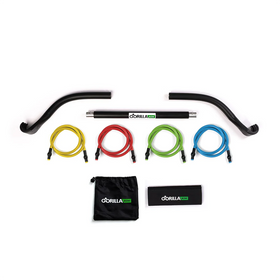How to Build Exercise Into Your Daily Routine

Many people with families, full-time jobs and other essential responsibilities struggle to find time for their health. However, you can always make time for the things you care about. Here are 10 tips to help you build exercise into your busy daily routine.
1. Find Exercises You Enjoy
People often lose motivation when their exercise routines become too draining. Instead of forcing yourself through a tortuous workout, experiment with other exercises and find the ones you enjoy. This advice also applies to your diet. Not everyone has the same reaction to standard activities and diet foods — everyone has different preferences.
One common issue people have is mental and physical burnout from doing heavy exercises. This reaction is normal, especially for those who aren’t accustomed to traditional weightlifting. If you can’t seem to overcome this problem, simply find more satisfying substitutes. For example, try the leg press or a squat machine if you don't like squatting.
You can also experience burnout when your workout routines get too dull and repetitive. You might not feel tired or in pain, but you simply don’t have the same enthusiasm for your workouts. The solution is the same — find other exercises that spark your interest, try new foods and do anything to spice up your routine and reignite your passion.
As a general rule, your workout should never feel like a chore. The activity needs to challenge your mental and physical strength, but it should also be fulfilling. You want to be excited to train every day. Periodically adjusting your exercise and diet plan can boost your motivation and help you stick to your daily routine.
2. Focus More on Your Recovery
If you’re still struggling to follow your routine despite having an enjoyable diet and workout plan, your problem is straightforward. You might be neglecting the third crucial part of a healthy lifestyle — recovery. Active bodies need sufficient rest, so you must pace yourself to maintain a long-term fitness routine.
Without proper recovery, your mind and body will quickly give up. This problem is one of the main reasons 90% of people give up the gym after just three months. The people who quit were so focused on short-term results that they neglected to let their bodies recover.
It can take many months to grow accustomed to frequent exercise, so you need to be patient and prioritize your recovery. Make sure you add these items to your daily routine:
- Get at least eight hours of sleep every night.
- Devote at least one day per week to recovery. You could only exercise three or four times per week and still see consistent results.
- Set a time limit for your workouts. One hour is the typical cut-off for most people, but it can even be 45 or 30 minutes.
- When in doubt, listen to your body. Sometimes you’ll be too sleep-deprived, sore or stiff to exercise. Take the day off and wait until you’re fully recovered to start training again.
Sleep and relaxation are the most crucial rest methods, but every activity throughout the day contributes to your body’s recovery. Your posture, work habits and stress management skills all impact your workout performance. A well-rounded daily routine includes a healthy balance between exercise and recovery.
3. Exercise With Others
Everyone needs a support system to achieve their long-term goals and fitness is no exception. If you’re struggling to get through your daily routine alone, enlist your loved ones to provide encouragement and accountability. You could also turn your workouts into social occasions in many ways:
- Join a recreational sports league with friends. You’re never too old for team sports.
- Start a new outdoor activity tradition with your family, such as a hiking or fishing trip.
- Go public with your goals. Talk about them to your friends and post them on social media. You may feel more external pressure to stick to your routine.
- Join an online community of like-minded people. There are tons of niche fitness communities for running, cycling, yoga, bodybuilding — the list goes on.
- Hire a personal trainer or start working out with a partner. You can get useful advice on demand and you may feel more confident at the gym.
- Sign up for group exercise classes. This unique workout environment gives you a greater incentive to show up every day because you’re competing against peers.
When you can’t find inspiration within yourself, you have to rely on other people. Don’t be afraid to involve your friends and family in your fitness journey. They will see you trying to improve yourself and be happy to help.
4. Exercise on Your Commute
If your school or job is a short distance away, try exercising on your commute instead of driving. You can jog or ride your bike. In either case, wear lightweight and bright clothes to make yourself visible to drivers. You can always bring an extra set of clothes if you get too sweaty or dirty.
Cycling and jogging are both great low-impact cardio exercises that burn tons of calories in a short timeframe. They’re also highly affordable because they don’t require any experience, memberships or advanced equipment. You just need some athletic clothes and a decent pair of running shoes.
5. Establish a Stretching Routine
Stretching isn’t a huge calorie burner, but it’s vital for your overall health. You should establish a full-body stretching routine and do it at least once daily to help relieve muscular discomfort and improve your athletic performance during your other activities. The pattern doesn’t have to be complex — just get up and move.
This tip is significant for people with desk jobs. You’re sitting around most of the day, so you need to find small ways to increase your activity level. Keeping your body loose and flexible will help prevent the onset of the neck, back and leg pain many desk workers experience.
6. Upgrade Your Workspace
Speaking of desk workers, people in sedentary jobs should upgrade their workspaces in any way possible. Human bodies don’t always agree with traditional desks and chairs, which causes poor posture and many other health problems. Instead of giving yourself chronic aches and pains, switch to more ergonomic furniture.
Today’s gaming chairs are more comfortable and adjustable than ever. Standing and treadmill desks are also gaining popularity in office environments. Carpets or other warm and soft flooring options also give your joints better support. These items help keep you nimble and comfortable, thus contributing to a healthier overall lifestyle.
7. Set a Daily Step Goal
No matter what environment you work in, you should set a daily step goal to keep your activity levels high. Ten thousand steps is a popular milestone because it’s a satisfying round number and has many positive benefits, including the prevention of cardiovascular diseases and certain types of cancer.
You might not think you can complete 10,000 steps in a day, but the number adds up quickly. Consider using a fitness tracking device to automatically count the steps so you don’t have to think about it. Trackers also record all kinds of interesting information about your body, such as sleep duration, heart rate and calories burned.
8. Take Advantage of Breaks
Busy people must take full advantage of every break they get throughout the day. You could do your stretching routine, contribute to your step goal or knock out a quick 10-minute workout. Any sort of movement is better than sitting on your phone doing nothing.
A quick burst of activity not only improves your bodily fitness, but also keeps you focused and may help your job performance. Exercise is a mental activity just as much as a physical activity — it impacts your mood, concentration and ability to process information. An active body means an active mind.
9. Eat Full Meals, Don’t Snack
If you feel too groggy to exercise every day, your diet might be to blame. Many people snack throughout the day instead of having breaks between meals. You might think more food leads to more energy, but the human body is designed to digest a handful of large meals, not many small meals. Snacking makes digestion more difficult, weighing you down and sapping your energy levels.
Daily exercise is only possible when you eat the right foods in the right quantities. Cut out the processed stuff, stop snacking and eat three to four healthy meals daily. This diet structure will give you the nutrients and energy to power through your busy schedule.
10. End Each Day With a Walk
A short walk is the perfect way to end the day. Doing low-intensity exercise before bed can improve your sleep quality and help you fall asleep faster. You should also avoid using electronics before trying to sleep. Instead of spending an hour scrolling on your phone, read a book or listen to a podcast to wind down.
You Always Have Time for Exercise
You might feel like you don’t have enough free time for exercise, but that’s often not true. You always have time for exercise, just like you always have time for the other things you care about. If you genuinely want to reach your fitness goals, your effort will show it. Remember these tips to construct an ideal daily exercise routine that fits with your other responsibilities.










Leave a comment